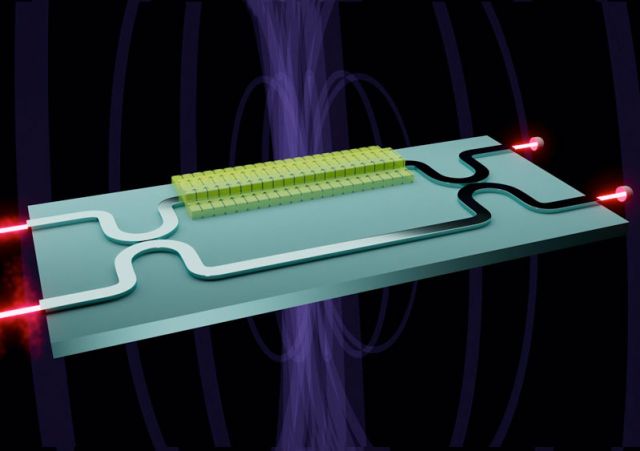UCSB Current – Moody & Pintus "Pursue Quantum-scale Sensor Technologies"
ECE's Prof. Galan Moody and scientist Paolo Pintus conduct NSF-funded research to pursue quantum-scale sensor technologies

Excerpt from The UCSB Current article "UC Santa Barbara Quantum Scientists to Conduct NSF-funded Research to Pursue Quantum-scale Sensor Technologies"
At the atomic and subatomic scales exist behaviors that have vast potential to enhance how we see and interact with the world, by improving current technologies and potentially giving rise to new ones. The main advantage to be gained from the realm of quantum sensing is its extreme sensitivity and accuracy, able to capture the faintest of signals and measure at the smallest of scales.
Now, several UC Santa Barbara researchers are poised to deploy their expertise in quantum science as part of the U.S. National Science Foundation’s (NSF) program Quantum Sensing Challenges for Transformational Advances in Quantum Systems (QuSeC-TAQS). They join a cohort of 18 research teams at universities across the U.S. backed by a $29 million investment from NSF to explore ways to harness the infinitesimal and sometimes counterintuitive quantum-scale properties of nature to create opportunities at the human scale.
The teams will each receive $1 million to $2 million over four years to conduct a broad range of exploratory research activities. The potential impacts are diverse, from the ability to sense gravitational waves as they ripple across space, to a means for witnessing the inner functions of living cells.
“For decades, scientific exploration at the quantum scale has yielded surprising discoveries about how our universe works — and tantalizing possibilities for quantum enabled technologies,” said NSF Director Sethuraman Panchanathan. “We are now taking the next step in quantum research through these projects and others, which combine fundamental research with potential applications that can positively impact our lives, our economic prosperity and our competitiveness as a nation.”
A quantum-enhanced optical magnetometer: Galan Moody and Paolo Pintus
As the name suggests, a magnetometer measures a magnetic field, and in doing so provides important information about targets in relationship to that field. A compass is a simple such device, revealing information about one’s direction relative to the Earth’s magnetic field. Scientists continue to leverage the elegant power of that technology in a growing list of applications, from archaeology to space exploration.
Electrical and computer engineering Professor Galan Moody and scientist Paolo Pintus aim to bring the high precision of quantum sensing to magnetometry, and build it all onto a chip. Think about LIGO, the laser interferometer that in 2015 detected the slightest of undulations generated by gravitational waves originating 1.3 billion light years away. The team will build an analogous interferometer experiment on a semiconductor chip that, rather than gravitational waves, can detect the slightest variations in magnetic fields.
“Instead of kilometer-scale detectors, we have millimeter-scale detectors,” said Pintus, who specializes in integrated optics. Their proposed photonic integrated magneto-optic interferometer would be unprecedented in its sensitivity — a 10-time enhancement beyond the standard quantum limit — built into a compact, energy efficient device that can be used for detecting minute magnetic fields with applications for navigation, geosciences and biomedicine, as well as space exploration.
Key to this novel, low-SWaP (size, weight and power) device is the use of quantum light. “We can build on decades of research and development to make magneto-optical sensors that don’t require any other bulky instrumentation, making them compact and portable,” said Moody, whose expertise lies in quantum photonics. “Usually, these sensors are powered by lasers, but there’s a limit to their sensitivity. Instead, by using squeezed light — a special kind of quantum light source that’s less noisy than a laser — we can go beyond this limit.”
Using squeezed light enables very precise measurements of the light waves’ phase in relationship to the target while also reducing the noise that could easily obscure high-precision measurements.
As part of the project, and in collaboration with partners at University of Cagliari in Italy and Professor Caroline Ross at Massachusetts Institute of Technology (MIT), the team intends to bring on a postdoctoral fellow to assist with research and education. They will also collaborate with colleagues at NASA, Luna Innovations and Raytheon.
“We also would like to spread the knowledge about quantum sciences to a broader audience,” Pintus commented, “for both outreach and for teaching classes within the UCSB and MIT programs.” At MIT, the research team led by Ross will focus on developing materials that could host the desired qualities of sensitivity and low-power consumption, while Moody and Pintus will work on embedding squeezed light and fabrication of the actual chip, respectively, using that material.
The UCSB Current – "UC Santa Barbara Quantum Scientists to Conduct NSF-funded Research to Pursue Quantum-scale Sensor Technologies" (full article)
Additional UCSB faculty highlighted in the article:
- ECE Prof. Dan Blumenthal – "Compact and robust quantum atomic sensors for timekeeping and inertial sensing"
- Physics Assoc. Prof. Andrew Jayich – "Novel quantum algorithms for optical atomic clocks"
- Physics Prof. Ania Jayich – "Quantum sensing platform for biomolecular analytics"